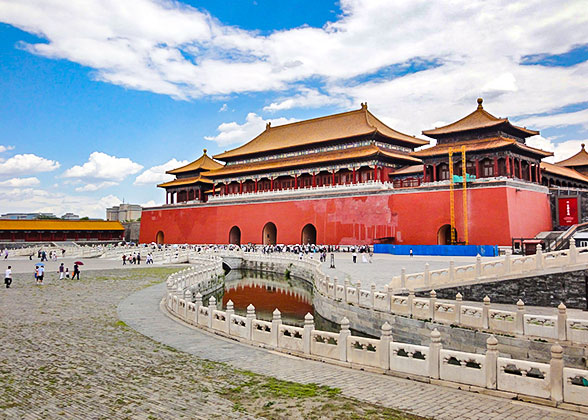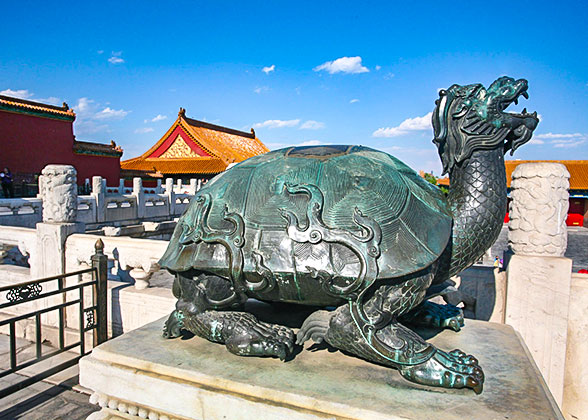One Day In-depth Forbidden City & Beijing Highlights
One Day Private Tour to National Museum, Tiananmen Square, Forbidden City, Jingshan Park, & Hutong Alleys by Rickshaw
From USD69 per person Book
- Itinerary
- Prices
- Reviews
Trip Highlights
- Witness untold treasurable collections in National Museum, the top arts center in China.
- Admire Chinese ancient architectural culture and royal anecdotes in Forbidden City.
- Get a bird’s-eye view of the entire Beijing city at the best vantage point in Jingshan Park.
- Deep into the genuine local life by taking a rickshaw through the traditional Hutong alleys.
- No commission-based shopping stops! More time will be spent on attractions and you will enjoy a pure sightseeing tour.
- Private guide and public transport, helping you save money while avoiding hassle.
This trip can be customized to meet your individual needs!
Meet your private guide at the lobby of your self-reserved hotel at the pre-agreed time of this morning, and then embark on a full day journey in Beijing together. First, let’s take the subway or bus to the National Museum. This low-carbon and environmentally friendly way of travel can not only save your budget, but also allows you to easily switch between different life and cultural scenarios to experience the diverse charm of Beijing. Rest assured that the seasoned guide will plan the most efficient public transport for you based on your hotel’s location.
► Things to Know:
1. Avoid scheduling the travel on Mondays, when both the National Museum and the Forbidden City are closed. Additionally, book the trip at least 8 days in advance, as tickets for the Forbidden City are only available for sale online 7 days before and will be snapped up instantly.
2. It’s better to only carry essential items like your passport. This way, you can quickly pass through the security checks at the National Museum and the Forbidden City, though you still need to prepare for long lines, especially during peak travel seasons and holidays.
► Things to Know:
1. Avoid scheduling the travel on Mondays, when both the National Museum and the Forbidden City are closed. Additionally, book the trip at least 8 days in advance, as tickets for the Forbidden City are only available for sale online 7 days before and will be snapped up instantly.
2. It’s better to only carry essential items like your passport. This way, you can quickly pass through the security checks at the National Museum and the Forbidden City, though you still need to prepare for long lines, especially during peak travel seasons and holidays.
When arriving at the National Museum, the top-notch treasure trove that holds the memories of 5,000 years of Chinese civilization, feast your eyes on countless key highlights of the collections, ranging from the rough tools of the Stone Age 2.5 million years ago to exquisite porcelain of the time when the last feudal emperor abdicated in 1912. In the Ancient China Exhibition on the basement floor, the Houmuwu Square Cauldron, the largest and heaviest bronze ware known in China, with mysterious dragon-like beast patterns meticulously cast on all sides, will leave you in awe of the superb craftsmanship of the artisans over 3,000 years ago. Also, marvel at the Phoenix Coronet, valued at 1.3 billion, whose top is decorated with 9 golden dragons and 9 golden phoenixes. Its blue trim, made from rare kingfisher feathers, still retains a vibrant color. Coupled with carefully selected rubies, sapphires, and pearls, the overall design exudes the ultimate luxury of royalty.
Coming out of the museum, let’s take a simple stroll on Tiananmen Square. Over the past 60-plus years since 1914, it has undergone numerous renovations and expansions, transforming from a T-shaped imperial long walkway into an immense venue that can now accommodate a million people for national gatherings. Under the wonderful explanations of your guide, appreciate those iconic buildings with symmetrical and balanced beauty here, especially the majestic Tiananmen Tower, which consists of a double-eaved structure and a bright red platform. Find the best camera position and pose in front of this symbol of Beijing and even China to take precious photos.
Later, make our way through the Tiananmen Tower to visit the Forbidden City, the world’s largest wooden architectural complex, which served as the residence of 24 emperors from 1420 to 1911 AD. After entering the Meridian Gate, let’s discover the main palaces and halls from south to the north, mainly along the central axis, including the Hall of Supreme Harmony, Hall of Central Harmony and Hall of Preserved Harmony of the Outer Court, and Palace of Heavenly Purity, Hall of Celestial and Terrestrial Union and Palace of Earthly Tranquility of the Inner Court, as well as the Imperial Garden.
When approaching the Hall of Supreme Harmony, the most important and largest structure in the Outer Court where the emperor handled state affairs, keep your eyes on its hipped roof paved with golden glazed tiles. The dragon-headed and fish-body beasts placed at both ends of the main ridge, which serve both waterproof and decorative roles, are the largest glazed components in the imperial palace. Moreover, be shocked to see on each eave, 10 distinctive divine beasts standing in a line, symbolizing the supreme status of this building, as the quantity is at most and the only even number.
Further north, you’ll get into the Inner Court, mainly used as the sleeping quarters for the emperors and empresses. The first to appear will be the Palace of Heavenly Purity, the formal abode of emperors. Some banquets were also held here every year during the Dragon Boat Festival, Mid-Autumn Festival, and Winter Solstice. Among them, the largest one is the Banquet for Elders, with over a thousand people in attendance. Surprisingly, what they ate was not the usual myriad of dishes, but steaming hot pots, which they enjoyed while drinking, beholding lanterns, and composing poems. What a pleasant scene!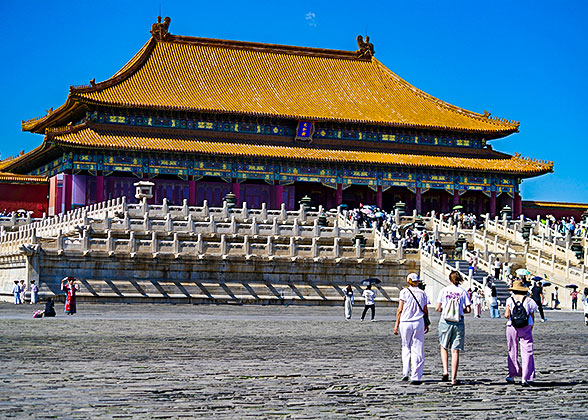
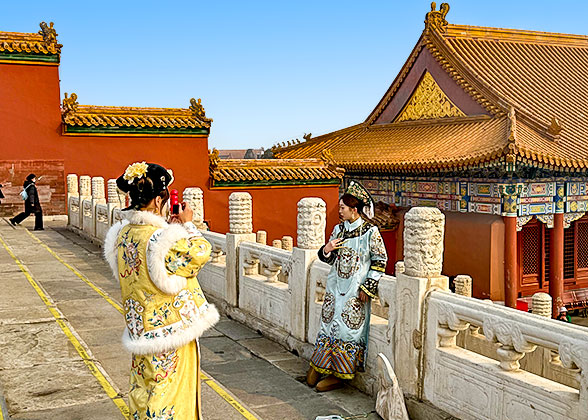
Afterward, you’ll reach the Imperial Garden, the place where the emperors and their spouses relax and admire the view, with orderly arranged pavilions and terraces and rare flowers and plants competing in beauty. When strolling here, your guide will remind you to pay special attention to a naturally formed strange rock, on which you’ll find that the pattern resembles a minister in official attire bowing with his hands in a respectful manner towards the ingeniously formed Big Dipper on the right. At the end of the visit, you’ll arrive at the northernmost Gate of Divine Prowess, also the exit of the Forbidden City.
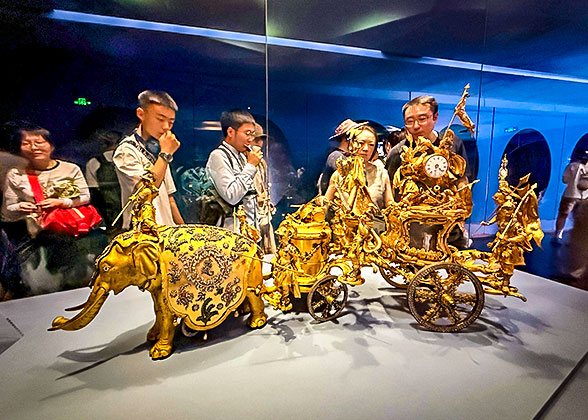
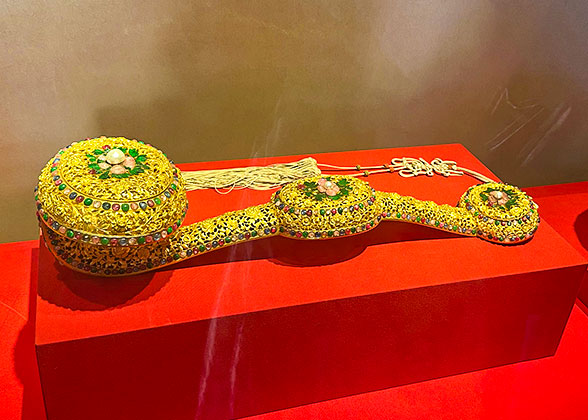
When approaching the Hall of Supreme Harmony, the most important and largest structure in the Outer Court where the emperor handled state affairs, keep your eyes on its hipped roof paved with golden glazed tiles. The dragon-headed and fish-body beasts placed at both ends of the main ridge, which serve both waterproof and decorative roles, are the largest glazed components in the imperial palace. Moreover, be shocked to see on each eave, 10 distinctive divine beasts standing in a line, symbolizing the supreme status of this building, as the quantity is at most and the only even number.
Further north, you’ll get into the Inner Court, mainly used as the sleeping quarters for the emperors and empresses. The first to appear will be the Palace of Heavenly Purity, the formal abode of emperors. Some banquets were also held here every year during the Dragon Boat Festival, Mid-Autumn Festival, and Winter Solstice. Among them, the largest one is the Banquet for Elders, with over a thousand people in attendance. Surprisingly, what they ate was not the usual myriad of dishes, but steaming hot pots, which they enjoyed while drinking, beholding lanterns, and composing poems. What a pleasant scene!

Forbidden City, Beijing

Forbidden City, Beijing
★ Enjoy a Visual Feast at Treasure Gallery & Gallery of Timepieces
We aim to make your visit the most worthwhile, so we won’t let you miss the two celebrated galleries set up in the northeast corner of the Forbidden City. When you are in the Treasure Gallery, the dazzling array of gemstones, gold and silver wares, pearls and jade, as well as ivory carvings, will leave you overwhelmed. There are also elaborately carved hairpins, bracelets, and rings, each revealing the refinement and elegance of royal women, waiting for you to discover. Stepping into the Gallery of Timepieces, you can’t help but gaze down at those delicate artworks made in the palace and from countries like the UK, France, and Switzerland in wonder, which not only simulate the classical beauty of pavilions and pagodas, but also show the exotic style of Western architecture, horses, and characters.Afterward, you’ll reach the Imperial Garden, the place where the emperors and their spouses relax and admire the view, with orderly arranged pavilions and terraces and rare flowers and plants competing in beauty. When strolling here, your guide will remind you to pay special attention to a naturally formed strange rock, on which you’ll find that the pattern resembles a minister in official attire bowing with his hands in a respectful manner towards the ingeniously formed Big Dipper on the right. At the end of the visit, you’ll arrive at the northernmost Gate of Divine Prowess, also the exit of the Forbidden City.

A Fine Clock at the Gallery of Timepieces

Beautiful Exhibit at the Treasure Gallery
Next, let’s continue northward through the underground passage to Jingshan Park, which is more than 400 years older than the Forbidden City and was the place where members of the royal families of successive dynasties climbing, sightseeing, and even performing rituals in ancient times. It only takes 15 minutes to hike to the summit of Jingshan Hill, once the highest point on the central axis of Beijing. Here, you’ll be greeted by the iconic Wanchun Pavilion, which features a three-eaved four-cornered pyramidal roof covered with yellow glazed tiles and trimmed with green edges, offering you a 360° view of the entire city of Beijing, with the grand Forbidden City to the south, the traditional Hutong alleys to the west, and the modern CBD complex to the east. Seize your chance to snap the postcard-like photos.
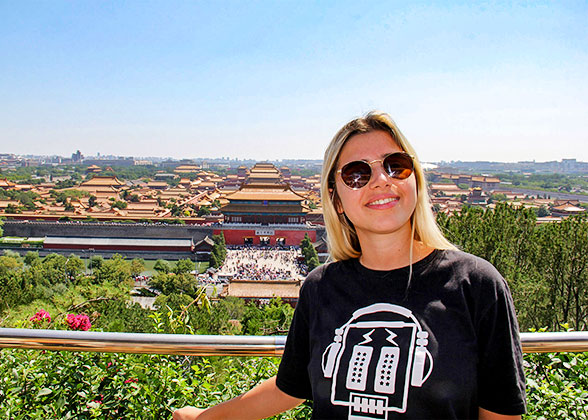
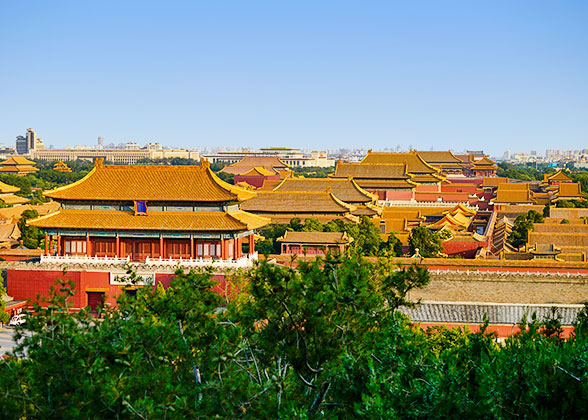

Our Guest in Jingshan Park

Jingshan Park, Beijing
After that, proceed to enjoy a rickshaw tour through the traditional Hutong alleys. Riding in a retro red-roofed black pedicab shuttling through the crisscross narrow lanes and looking at the mottled walls and old wooden doors of those quaint quadrangle courtyards, you’ll feel as if you could travel through time to appreciate the unique charm of authentic old Beijing life. Along the way, you may notice that on the gate piers on both sides of the doorways there are various carvings, which are said to be the ‘ID cards’ of the courtyards, hiding the identity and status information of the owners - flat ones carved with simple flower and plant patterns are often used in civilian families, while square ones engraved with books or inkstones represent the scholarly families, and round ones sculpted with lions suggest that they are families of military officials. Also, let’s pay a family visit in a yard, observe its architectural details, chat with hospitable hosts, and thereby understand the local Beijingers’ lifestyles.
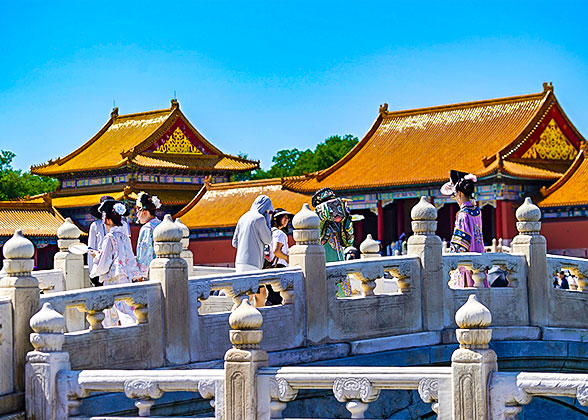
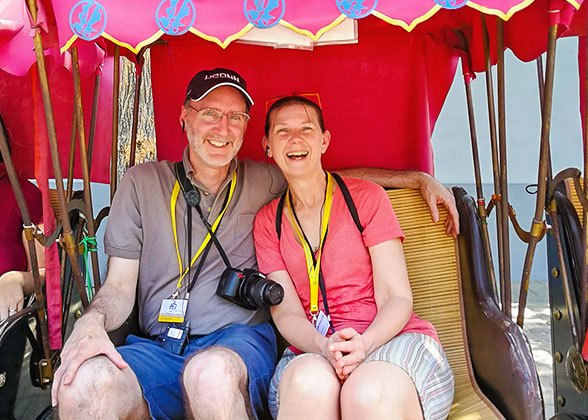

Visit the Forbidden City

Rickshaw Ride at the Hutong Alleys
By now, your private day tour to Forbidden City and highlight attractions of Beijing has come to a happy ending, and your guide will escort you on public transport back to your hotel. Thank you for traveling with us! If your tour time is particularly limited, focus your attention on our half-day Forbidden City tour; or if you have more time to witness other national marvels, like the Great Wall of China, royal garden landscapes of Summer Palace, and adorable giant pandas, consider our 3 to 6 days’ classic tours. Welcome to contact us anytime for a customized Beijing trip just to your interests.
► Recommended Nighttime Activities (at your own expense):
If you don’t want to return to the hotel immediately after the tour, you can wander around the nearby Shichahai Lake, also known as the ‘eye of Beijing’, on your own, and finally go back to the hotel by yourself. Try a bowl of Noodles with Soybean Paste for around CNY 30 (USD 4) for dinner at one of the many specialty food restaurants. Its unique flavor of secret sauce, when mixed with the chewy noodles, is sure to stimulate your taste buds. Then stroll along the lakeside, watching the afterglow of the setting sun sprinkle on the water and feeling the coolness of the gentle breeze caressing your face. If you get tired from walking, go to an atmospheric bar, listen to the melodious folk songs, sip jolly cocktails, and let all the fatigue of the day vanish.
► Recommended Nighttime Activities (at your own expense):
If you don’t want to return to the hotel immediately after the tour, you can wander around the nearby Shichahai Lake, also known as the ‘eye of Beijing’, on your own, and finally go back to the hotel by yourself. Try a bowl of Noodles with Soybean Paste for around CNY 30 (USD 4) for dinner at one of the many specialty food restaurants. Its unique flavor of secret sauce, when mixed with the chewy noodles, is sure to stimulate your taste buds. Then stroll along the lakeside, watching the afterglow of the setting sun sprinkle on the water and feeling the coolness of the gentle breeze caressing your face. If you get tired from walking, go to an atmospheric bar, listen to the melodious folk songs, sip jolly cocktails, and let all the fatigue of the day vanish.
This trip can be customized to meet your individual needs!
Tour Prices
| 1 traveler | 2-3 travelers | 4-5 travelers |
|---|---|---|
USD159 | USD99 | USD69 |
Price Includes
- Private English-speaking guide
- Public transport fares
- Entrance fees as indicated above
Price Excludes
- Accommodation & meals
- Personal expenses
- Gratuities for guide
Itineraries you may also like:

